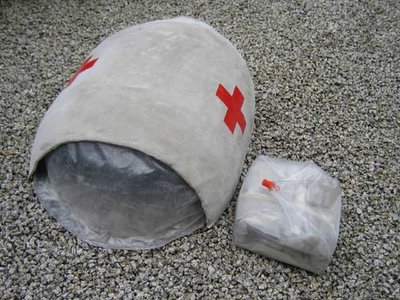Tent City Urbanism

[Image: Bulding in a Bag, 18 Mar 2005 by Raymond Powers]
When this project first broke out in the media last year, the blogowans ate it up for its innovative application of concrete and structural flexibility to disaster-torn landscapes. A brilliant design, Concrete Canvas is the invention of two British engineers who have been stacking up numerous awards for it, namely the Saatchi & Saatchi Award for World Changing Ideas just a few days ago. It's a prefabricated concrete bag folded inside a giant sack. Intructions for use are as difficult as: 'Add water, cut sack, unfold concrete bag, and inflate a central bubble to support the tent until it dries.' Simple, smart, addresses key durability and user friendly issues, and actually covers a full 16 sq meters. They look like supersized concrete igloos, or insta-bunkers, crude pop-up architecture for a ballooning global refugee urbanism.

[Image: Inflatable Concrete Forms Shelter, Discovery Channel, 2005]
But, as big interest has developed and a desire to test them more liberally in the field, some experts are shying away from the concrete canvas with what sounds like some good sense practical skepticism.
Alternet reported a few days ago: “At first sight it looks marvelous,” said Rishi Ramrakha, a logistics officer at the British Red Cross Society. “But the real practicalities look a bit difficult.” According to Ramrakha, there are several central problems. First, the unit is too heavy to be carried easily into areas where there might not be access for aircraft or trucks. The second is the amount of water needed to erect each tent. “Where are you going to get 145 liters in a disaster zone?”
Displaced populations are accommodated in temporary shelter because they will eventually be encouraged either to go back to where they came from, or to make homes and a new life in a better place. The construction of permanent structures, particularly in conflict zones, could hamper that process."
It's a good point, one no one can seem to resolve just yet: how to build temporary shelters in balance with longer range housing relief programs, so that the shelter neither encourages an extended-temporary use nor fails to meet the immediate impact needs for not having been the most intelligent shelter system we were capable of building. So, maybe this is a good medium - deployable concrete. Or maybe it's just a deeper sign of even our sincerest efforts ironically cementining the Tent City crisis in a post-disaster ignorance of failed planning and continual site paralysis.
See these other 'flexible concrete' projects: Communist Block Renaissance | Grancrete | Light transmitting concrete | Heat-sensitive and communicating concrete | Houses built by robot | Carbon-Eating Cement | Bendable concrete | AFH (Rethinking Tent City) | Concrete graves a hazard to us all | Tent City, USA







1 Comments:
Read an interview with designers Peter Brewin and Will Crawford in designboom.
Post a Comment
<< Home